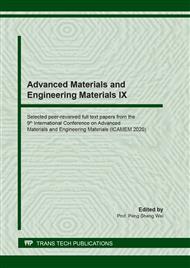[1]
G. Kibria, B. Doloi, B. Bhattacharyya, Experimental analysis on Nd:YAG laser micro-turning of alumina ceramic, The International Journal of Advanced Manufacturing Technology. 50 (2010) 643–650.
DOI: 10.1007/s00170-010-2527-4
Google Scholar
[2]
D. Dhupal, B.Doloi, B. Bhattacharyya, Pulsed Nd:YAG laser turning of micro-groove on aluminum oxide ceramic (Al2O3), International Journal of Machine Tools & Manufacture. 48 (2008) 236–248.
DOI: 10.1016/j.ijmachtools.2007.08.016
Google Scholar
[3]
G. Kibria, Leeom P. Lepcha, I. Shivakoti, B. Doloi, B. Bhattacharyya, Pulsed Nd:YAG Laser Micro-turning of Alumina to Study the Effect of Overlap Factors on Surface Roughness Performance, IOP Conference Series: Materials Science and Engineering. 377 (2018) 1-7.
DOI: 10.1088/1757-899x/377/1/012185
Google Scholar
[4]
V. Tangwarodomnukun, J. Wang, P. Mathew, A comparison of dry and underwater laser micromachining of silicon substrates, Key Engineering Materials. 443 (2010) 693-698.
DOI: 10.4028/www.scientific.net/kem.443.693
Google Scholar
[5]
W. Charee, V.Tangwarodomnukun, Dynamic features of bubble induced by a nanosecond pulse laser in still and flowing water, Optics & Laser Technology. 100 (2018) 230-243.
DOI: 10.1016/j.optlastec.2017.10.019
Google Scholar
[6]
N. Iwatani, H.D. Doan, K. Fushinobu, Optimization of near-infrared laser drilling of silicon carbide underwater, International Journal of Heat and Mass Transfer. 71 (2014) 515-520.
DOI: 10.1016/j.ijheatmasstransfer.2013.12.046
Google Scholar
[7]
W. Charee, V.Tangwarodomnukun, Underwater Laser Micromilling of Commercially-Pure Titanium Using Different Scan Overlaps, IOP Conference Series: Materials Science and Engineering. 303 (2018) 1-6.
DOI: 10.1088/1757-899x/303/1/012015
Google Scholar
[8]
W. Charee, V.Tangwarodomnukun, C. Dumkum, Laser ablation of silicon in water under different flow rates, International Journal of Advanced Manufacturing Technology. 78 (2015) 19-29.
DOI: 10.1007/s00170-014-6625-6
Google Scholar
[9]
V. Tangwarodomnukun, Cavity formation and surface modeling of laser milling process under a thin-flowing water layer, Applied Surface Science. 386 (2016) 51–64.
DOI: 10.1016/j.apsusc.2016.06.011
Google Scholar
[10]
T. Wuttasarn, V.Tangwarodomnukun, C. Dumkum, Laser micro-milling under a thin and flowing water layer: A new concept of liquid-assisted laser machining process, Proceedings of the Institution of Mechanical Engineers, Part B: Journal of Engineering Manufacture. 230 (2015) 376-380.
DOI: 10.1177/0954405415580542
Google Scholar


